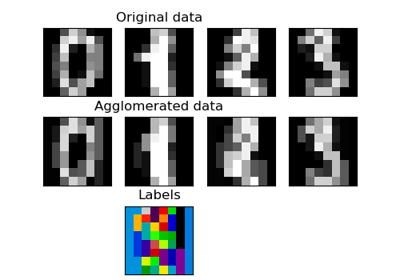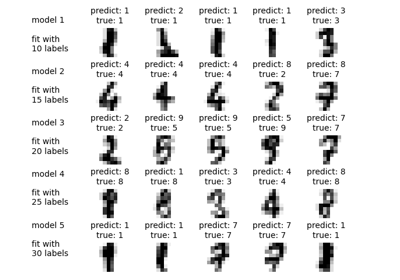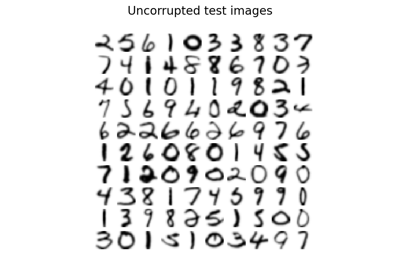Note
Go to the end to download the full example code or to run this example in your browser via JupyterLite or Binder.
Recognizing hand-written digits#
This example shows how scikit-learn can be used to recognize images of hand-written digits, from 0-9.
# Authors: The scikit-learn developers
# SPDX-License-Identifier: BSD-3-Clause
# Standard scientific Python imports
import matplotlib.pyplot as plt
# Import datasets, classifiers and performance metrics
from sklearn import datasets, metrics, svm
from sklearn.model_selection import train_test_split
Digits dataset#
The digits dataset consists of 8x8
pixel images of digits. The images attribute of the dataset stores
8x8 arrays of grayscale values for each image. We will use these arrays to
visualize the first 4 images. The target attribute of the dataset stores
the digit each image represents and this is included in the title of the 4
plots below.
Note: if we were working from image files (e.g., ‘png’ files), we would load
them using matplotlib.pyplot.imread.
digits = datasets.load_digits()
_, axes = plt.subplots(nrows=1, ncols=4, figsize=(10, 3))
for ax, image, label in zip(axes, digits.images, digits.target):
ax.set_axis_off()
ax.imshow(image, cmap=plt.cm.gray_r, interpolation="nearest")
ax.set_title("Training: %i" % label)

Classification#
To apply a classifier on this data, we need to flatten the images, turning
each 2-D array of grayscale values from shape (8, 8) into shape
(64,). Subsequently, the entire dataset will be of shape
(n_samples, n_features), where n_samples is the number of images and
n_features is the total number of pixels in each image.
We can then split the data into train and test subsets and fit a support vector classifier on the train samples. The fitted classifier can subsequently be used to predict the value of the digit for the samples in the test subset.
# flatten the images
n_samples = len(digits.images)
data = digits.images.reshape((n_samples, -1))
# Create a classifier: a support vector classifier
clf = svm.SVC(gamma=0.001)
# Split data into 50% train and 50% test subsets
X_train, X_test, y_train, y_test = train_test_split(
data, digits.target, test_size=0.5, shuffle=False
)
# Learn the digits on the train subset
clf.fit(X_train, y_train)
# Predict the value of the digit on the test subset
predicted = clf.predict(X_test)
Below we visualize the first 4 test samples and show their predicted digit value in the title.
_, axes = plt.subplots(nrows=1, ncols=4, figsize=(10, 3))
for ax, image, prediction in zip(axes, X_test, predicted):
ax.set_axis_off()
image = image.reshape(8, 8)
ax.imshow(image, cmap=plt.cm.gray_r, interpolation="nearest")
ax.set_title(f"Prediction: {prediction}")

classification_report builds a text report showing
the main classification metrics.
print(
f"Classification report for classifier {clf}:\n"
f"{metrics.classification_report(y_test, predicted)}\n"
)
Classification report for classifier SVC(gamma=0.001):
precision recall f1-score support
0 1.00 0.99 0.99 88
1 0.99 0.97 0.98 91
2 0.99 0.99 0.99 86
3 0.98 0.87 0.92 91
4 0.99 0.96 0.97 92
5 0.95 0.97 0.96 91
6 0.99 0.99 0.99 91
7 0.96 0.99 0.97 89
8 0.94 1.00 0.97 88
9 0.93 0.98 0.95 92
accuracy 0.97 899
macro avg 0.97 0.97 0.97 899
weighted avg 0.97 0.97 0.97 899
We can also plot a confusion matrix of the true digit values and the predicted digit values.
disp = metrics.ConfusionMatrixDisplay.from_predictions(y_test, predicted)
disp.figure_.suptitle("Confusion Matrix")
print(f"Confusion matrix:\n{disp.confusion_matrix}")
plt.show()
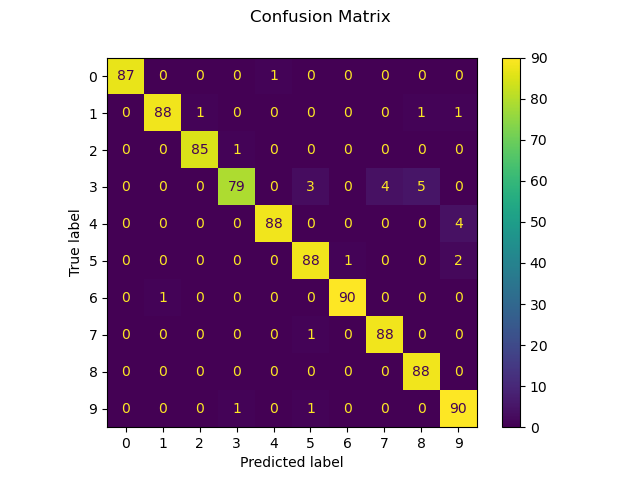
Confusion matrix:
[[87 0 0 0 1 0 0 0 0 0]
[ 0 88 1 0 0 0 0 0 1 1]
[ 0 0 85 1 0 0 0 0 0 0]
[ 0 0 0 79 0 3 0 4 5 0]
[ 0 0 0 0 88 0 0 0 0 4]
[ 0 0 0 0 0 88 1 0 0 2]
[ 0 1 0 0 0 0 90 0 0 0]
[ 0 0 0 0 0 1 0 88 0 0]
[ 0 0 0 0 0 0 0 0 88 0]
[ 0 0 0 1 0 1 0 0 0 90]]
If the results from evaluating a classifier are stored in the form of a
confusion matrix and not in terms of y_true and
y_pred, one can still build a classification_report
as follows:
# The ground truth and predicted lists
y_true = []
y_pred = []
cm = disp.confusion_matrix
# For each cell in the confusion matrix, add the corresponding ground truths
# and predictions to the lists
for gt in range(len(cm)):
for pred in range(len(cm)):
y_true += [gt] * cm[gt][pred]
y_pred += [pred] * cm[gt][pred]
print(
"Classification report rebuilt from confusion matrix:\n"
f"{metrics.classification_report(y_true, y_pred)}\n"
)
Classification report rebuilt from confusion matrix:
precision recall f1-score support
0 1.00 0.99 0.99 88
1 0.99 0.97 0.98 91
2 0.99 0.99 0.99 86
3 0.98 0.87 0.92 91
4 0.99 0.96 0.97 92
5 0.95 0.97 0.96 91
6 0.99 0.99 0.99 91
7 0.96 0.99 0.97 89
8 0.94 1.00 0.97 88
9 0.93 0.98 0.95 92
accuracy 0.97 899
macro avg 0.97 0.97 0.97 899
weighted avg 0.97 0.97 0.97 899
Total running time of the script: (0 minutes 0.376 seconds)
Related examples
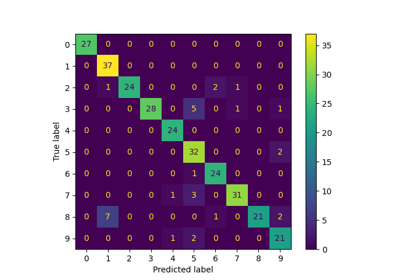
Label Propagation digits: Demonstrating performance
